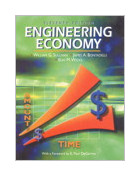William G. Sullivan ,
Virginia Polytechnic Institute and State University
James A. Bontadelli , The University of Tennessee
Elin M. Wicks , University of Missouri, Columbia
Published August 1999 by Engineering/Science/Mathematics
Copyright 2000, 662 pp.
Cloth ISBN 0-13-011570-3
For undergraduate,
introductory courses in Engineering Economics.
Used by over 500,000
students, this best-selling text provides a sound understanding of the principles, basic
concepts, and methodology of engineering economy. Built upon the rich and time-tested
teaching materials of earlier editions, it is extensively revised and updated to reflect
current trends and issues, with an emphasis on the economics of engineering design
throughout. It provides one of the most complete and up-to-date studies of this vitally
important field.
NEW-More design
economics problems and cost estimating.
NEW-A full chapter on
Communicating Engineering Economy Study Results (Ch. 15).
NEW-Global issues-Discussed
in terms of exchange rate problems.
NEW-Deflation effects on
project economics highlighted.
NEW-New and updated
end-of-chapter problems.
NEW-Test Companion
Website www.prenhall.com/sullivan-Devoted to electronic media that supports
engineering economy courses.
NEW-Student portfolios-Offers
suggestions for creating and using student portfolios to facilitate integrated learning of
topics in engineering economy.
NEW-Economic Value Added-Uses
an after-tax cash flow analysis to explain the concept of "economic value added."
NEW-Cost of capital-Explains
the cost of equity and debt capital as well as the weighted average cost of capital and
its relationship to rate of return concepts.
Real-world engineering
economy analysis methodology.
Case studies-Demonstrates
the integrated application of the principles, basic concepts, and methodology used by
engineers in typical, real-world situations.
Cost estimating, design
economics, and electronic spreadsheets.
Capital investments-Examines
the theoretical and practical aspects of selecting among capital investments.
Internet-accessible
electronic spreadsheets-Provides approximately 50 basic templates for all major
topics in the text and summarizes formulas and key concepts.
Examples.
I. FUNDAMENTALS OF
ENGINEERING ECONOMY.
1. Introduction to
Engineering Economy.
2. Cost Concepts and Design Economics.
3. Money-Time Relationships and Equivalence.
II. BASIC TOPICS IN
ENGINEERING ECONOMY.
4. Applications of
Money-Time Relationships.
5. Comparing Alternatives.
6. Depreciation and Income Taxes.
7. Cost Estimating Techniques.
8. Price Changes and Exchange Rates.
9. Replacement Analysis.
10. Dealing With Uncertainty.
III. ADDITIONAL TOPICS IN
ENGINEERING ECONOMY.
11. Public Projects and
the Benefit/Cost Ratio Method.
12. Engineering Economy Studies in Investor-Owned Utilities.
13. Probabilistic Risk Analysis.
14. Capital Financing and Allocation.
15. Communicating Engineering Economy Study Results.
Appendixes .
Księgarnia nie działa. Nie odpowiadamy na pytania i nie realizujemy zamówien. Do odwolania !.


